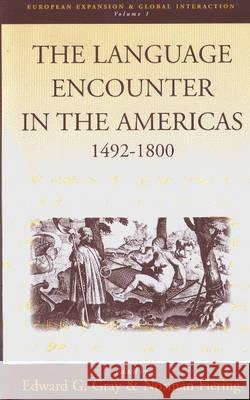The Language Encounter in the Americas, 1492-1800 » książka
The Language Encounter in the Americas, 1492-1800
ISBN-13: 9781571812100 / Angielski / Twarda / 2000 / 352 str.
The Language Encounter in the Americas, 1492-1800
ISBN-13: 9781571812100 / Angielski / Twarda / 2000 / 352 str.
(netto: 528,58 VAT: 5%)
Najniższa cena z 30 dni: 539,00 zł
ok. 22 dni roboczych.
Darmowa dostawa!
"Although the various essays focus on different sets of issues and perspectives, the unifying theme of linguistic or communicative interaction ties them together in complementary ways ... The editors and authors ... have done an excellent job of avoiding esoteric methodologies ... This is a very acceptable interdisciplinary book that will be essential for anyone interested in European and indigenous contacts in the colonial period." - H-Net Reviews (H-LatAm) "This collection is a very welcome addition to scholarship on Native-European encounters in the New World ... Both the broad coverage and the interdisciplinary approaches ... will offer future scholars of colonial situations conceptual tools ... a strong and accessible collection that will lead scholars of diverse subfields in very profitable common directions." - Indigenous Nations Studies " A] fascinating volume and] valuable reference for future work." - American Studies International When Columbus arrived in the Americas there were, it is believed, as many as 2,000 distinct, mutually unintelligible tongues spoken in the western hemisphere, encompassing the entire area from the Arctic Circle to Tierra del Fuego. This astonishing fact has generally escaped the attention of historians, in part because many of these indigenous languages have since become extinct. And yet the burden of overcoming America's language barriers was perhaps the one problem faced by all peoples of the New World in the early modern era: African slaves and Native Americans in the Lower Mississippi Valley; Jesuit missionaries and Huron-speaking peoples in New France; Spanish conquistadors and the Aztec rulers. All of these groups confronted America's complex linguistic environment, and all of them had to devise ways of transcending that environment - a problem that arose often with life or death implications. For the first time, historians, anthropologists, literature specialists, and linguists have come together to reflect, in the fifteen original essays presented in this volume, on the various modes of contact and communication that took place between the Europeans and the "Natives." A particularly important aspect of this fascinating collection is the way it demonstrates the interactive nature of the encounter and how Native peoples found ways to shape and adapt imported systems of spoken and written communication to their own spiritual and material needs. Edward G. Gray is Assistant Professor of History at Florida State University. Norman Fiering is the author of two books that were awarded the Merle Curti Prize for Intellectual History by the Organization of American Historians and of numerous. Since 1983, he has been Director of the John Carter Brown Library at Brown University.
"Although the various essays focus on different sets of issues and perspectives, the unifying theme of linguistic or communicative interaction ties them together in complementary ways ... The editors and authors ... have done an excellent job of avoiding esoteric methodologies ... This is a very acceptable interdisciplinary book that will be essential for anyone interested in European and indigenous contacts in the colonial period." · H-Net Reviews (H-LatAm)
"This collection is a very welcome addition to scholarship on Native-European encounters in the New World ... Both the broad coverage and the interdisciplinary approaches ... will offer future scholars of colonial situations conceptual tools ... a strong and accessible collection that will lead scholars of diverse subfields in very profitable common directions." · Indigenous Nations Studies
"[A] fascinating volume [and] valuable reference for future work." · American Studies International
When Columbus arrived in the Americas there were, it is believed, as many as 2,000 distinct, mutually unintelligible tongues spoken in the western hemisphere, encompassing the entire area from the Arctic Circle to Tierra del Fuego. This astonishing fact has generally escaped the attention of historians, in part because many of these indigenous languages have since become extinct. And yet the burden of overcoming Americas language barriers was perhaps the one problem faced by all peoples of the New World in the early modern era: African slaves and Native Americans in the Lower Mississippi Valley; Jesuit missionaries and Huron-speaking peoples in New France; Spanish conquistadors and the Aztec rulers. All of these groups confronted Americas complex linguistic environment, and all of them had to devise ways of transcending that environment - a problem that arose often with life or death implications.
For the first time, historians, anthropologists, literature specialists, and linguists have come together to reflect, in the fifteen original essays presented in this volume, on the various modes of contact and communication that took place between the Europeans and the "Natives." A particularly important aspect of this fascinating collection is the way it demonstrates the interactive nature of the encounter and how Native peoples found ways to shape and adapt imported systems of spoken and written communication to their own spiritual and material needs.
Edward G. Gray is Assistant Professor of History at Florida State University.
Norman Fiering is the author of two books that were awarded the Merle Curti Prize for Intellectual History by the Organization of American Historians and of numerous. Since 1983, he has been Director of the John Carter Brown Library at Brown University.











